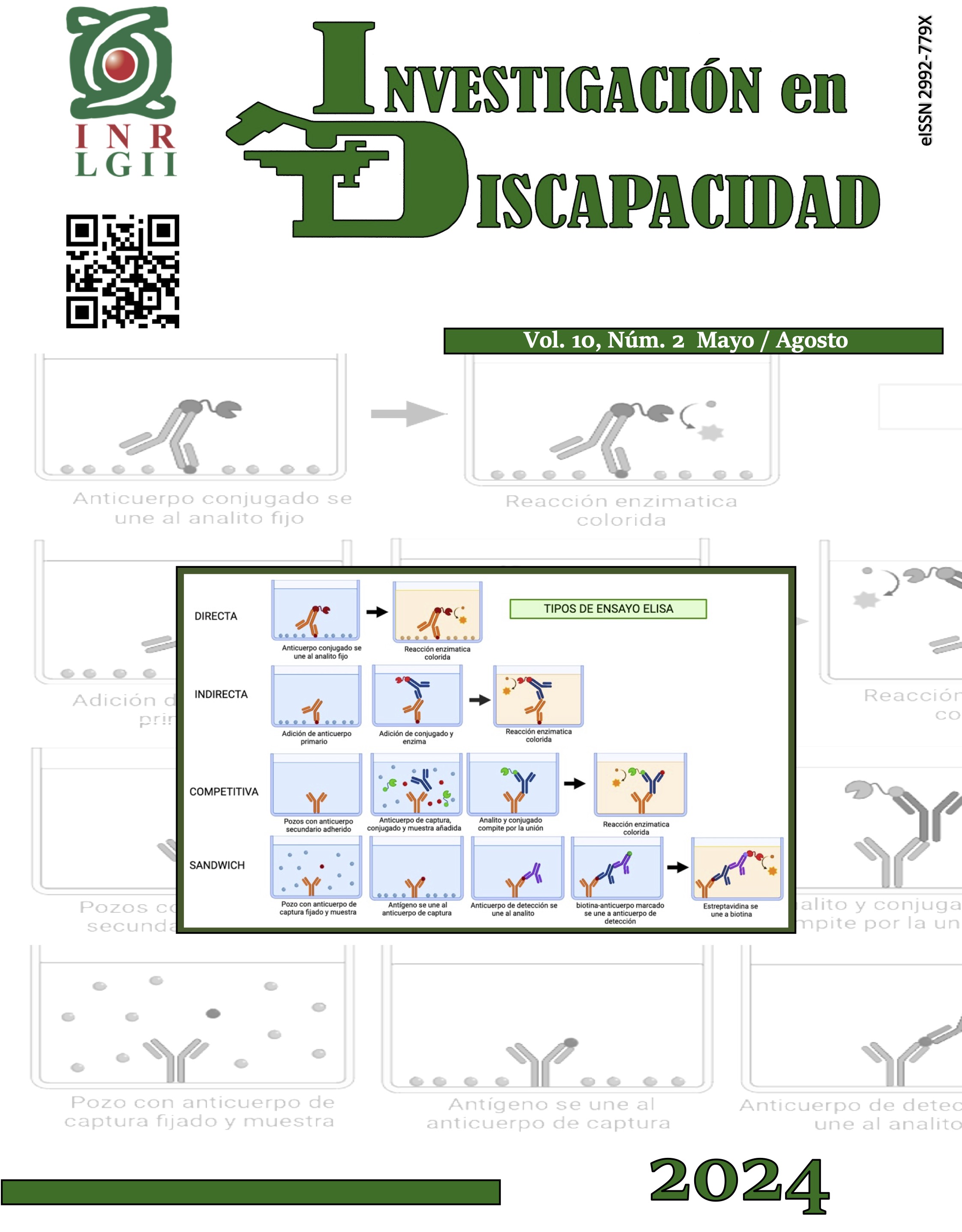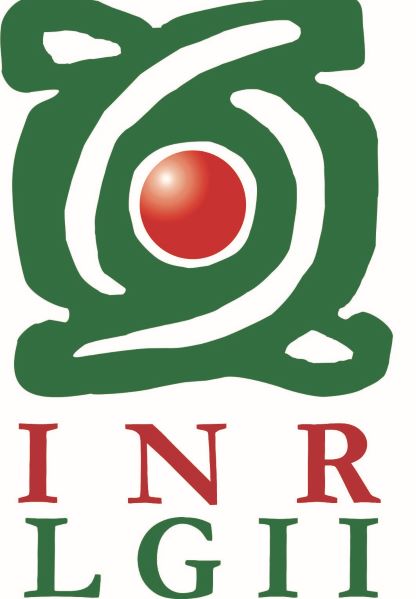Acondroplasia: 10 años de experiencia en el abordaje clínico, manejo y atención multidisciplinaria en el Instituto Nacional de Rehabilitación «Luis Guillermo Ibarra Ibarra»
DOI:
https://doi.org/10.35366/116870Palabras clave:
acondroplasia, displasia ósea, FGFR3, abordaje clínicoResumen
Introducción: la acondroplasia es la displasia esquelética más común a nivel mundial con una incidencia de 1 en 20- 30 mil individuos; se estima que el 80% de los casos son de presentación de novo. La acondroplasia es una enfermedad con una herencia autosómica dominante, causada por variantes patogénicas en el gen FGFR3 (receptor del factor de crecimiento de fibroblastos tipo 3). Existen múltiples manifestaciones clínicas dentro de las cuales destaca talla baja no proporcionada con acortamiento rizomélico. Material y métodos: se realizó un estudio observacional, retrospectivo, de 42 pacientes con diagnóstico de acondroplasia atendidos en el INRLGII entre los años 2013- 2023. Se registraron las variables: sexo, edad actual, edad al momento del diagnóstico, años de seguimiento.Resultados: se obtuvo el registro de 42 pacientes provenientes de 13 diferentes estados de la República Mexicana, principalmen te de la Ciudad de México (42.8%) y del Estado de México (23.8%). Considerando los 42 pacientes, 52.4% fueron hombres y 47.6% mujeres. Del total de pacientes, sólo el 9.5% fueron diagnosticados prenatalmente. Conclusiones: es fundamental realizar un enfoque multidisciplinario y proactivo para la atención clínica y psicosocial de las personas con acondroplasia y contar con acceso a un genetista para un adecuado asesoramiento.
##plugins.generic.pfl.publicationFactsTitle##
##plugins.generic.pfl.reviewerProfiles## N/D
##plugins.generic.pfl.authorStatements##
Indexado: {$indexList}
-
##plugins.generic.pfl.indexedList##
- ##plugins.generic.pfl.academicSociety##
- N/D
Citas
SavarirayanR,IrelandP,IrvingM,ThompsonD,AlvesI, Baratela WAR et al. International Consensus Statement on the diagnosis, multidisciplinary management and lifelong care of individuals with achondroplasia. Nat Rev Endocrinol. 2022; 18 (3): 173-189. doi: 10.1038/ s41574-021-00595-x.
Wood KA, Goriely A. The impact of paternal age on new mutations and disease in the next generation. Fertil Steril. 2022; 118 (6):1001-1012. doi: 10.1016/j. fertnstert.2022.10.017.
Pauli RM. Achondroplasia: a comprehensive clinical review. Orphanet J Rare Dis. 2019; 14 (1): 1. doi: 10.1186/s13023-018-0972-6.
Ornitz DM, Legeai-Mallet L. Achondroplasia: development, pathogenesis, and therapy. Dev Dyn. 2017; 246 (4): 291-309. doi: 10.1002/dvdy.24479.
Foreman PK, van Kessel F, van Hoorn R, van den Bosch J, Shediac R, Landis S. Birth prevalence of
achondroplasia: a systematic literature review and meta-
analysis. Am J Med Genet A. 2020; 182: 2297-2316. 5. Eswarakumar VP, Lax I, Schlessinger J. Cellular signaling by fibroblast growth factor receptors. Cytokine
Growth Factor Rev. 2005; 16: 139-149.
Thomson RE, Kind PC, Graham NA, Etherson ML,
Kennedy J, Fernandes AC et al. FGF receptor 3 activation promotes selective growth and expansion of occipitotemporal cortex. Neural Dev. 2009; 4: 4.
Daugherty A. Achondroplasia: etiology, clinical presentation, and management. Neonatal Netw. 2017; 36 (6): 337-342. doi: 10.1891/0730-0832.36.6.337.
HortonWA,HallJG,HechtJT.Achondroplasia.Lancet. 2007; 370 (9582): 162-172.
Ireland PJ, Donaghey S, McGill J, Zankl A, Ware RS, Pacey V et al. Development in children with achondroplasia: a prospective clinical cohort study. Dev Med Child Neurol. 2012; 54: 532-537.
White KK, Bompadre V, Goldberg MJ, Bober MB, Campbell JW, Cho TJ et al. Best practices in the evaluation and treatment of foramen magnum stenosis in achondroplasia during infancy. Am J Med Genet A. 2016; 170A (1): 42-51. doi: 10.1002/ajmg.a.37394.
Leiva-Gea A, Martos Lirio MF, Barreda Bonis AC, Marín Del Barrio S, Heath KE, Marín Reina P et al. Achondroplasia: update on diagnosis, follow-up and treatment. An Pediatr (Engl Ed). 2022; 97 (6): 423.e1- 423.e11. doi: 10.1016/j.anpede.2022.10.004.
Collins WO, Choi SS. Otolaryngologic manifestations of achondroplasia. Arch Otolaryngol Head Neck Surg. 2007; 133: 237-244.
Berkowitz RG, Grundfast KM, Scott C, Saal H, Stern H, Rosenbaum K. Middle ear disease in childhood achondroplasia. Ear Nose Throat J. 1991; 70: 305-308.
IrelandPJ,PaceyV,ZanklA,EdwardsP,JohnstonLM, Savarirayan R. Optimal management of complications associated with achondroplasia. Appl Clin Genet. 2014; 7: 117-125.
Wrobel W, Pach E, Ben-Skowronek I. Advantages and disadvantages of different treatment methods in achondroplasia: a review. Int J Mol Sci. 2021; 22 (11): 5573.
“Voxzogo APMDS”. Therapeutic goods administration (TGA). 4 August 2022. Archived from the original on 6 August 2022. Retrieved 6 August 2022.
ClinicaltrialnumberNCT02055157for“Aphase2study of BMN 111 to evaluate safety, tolerability, and efficacy in children with achondroplasia (ACH)” at ClinicalTrials.gov
Duggan S. Vosoritide: first approval. Drugs. 2021; 81 (17): 2057-2062. doi: 10.1007/s40265-021-01623-w.
Komla-Ebri D, Dambroise E, Kramer I, Benoist-Lasselin C, Kaci N, Le Gall C et al. Tyrosine kinase inhibitor NVP- BGJ398 functionally improves FGFR3-related dwarfism in mouse model. J Clin Invest. 2016; 126 (5): 1871-1884.
Lacouture ME, Sibaud V, Anadkat MJ, Kaffenberger B, Leventhal J, Guindon K et al. Dermatologic adverse events associated with selective fibroblast growth
factor receptor inhibitors: overview, prevention, and management guidelines. Oncologist. 2021; 26 (2): e316-e326.
CNDH. Comisión Nacional de los Derechos Humanos [Ciudad de México, a 25 de octubre de 2018]. Más De 11,000 personas de talla baja enfrentan barreras que les impiden el ejercicio pleno de sus derechos humanos, afirma la CNDH [Comunicado de prensa]. Disponible en: www.cndh.org.mx/sites/default/files/doc/ Comunicados/2018/Com_2018_328.pdf
Godoy Escobar I. Acondroplasia: revisión de 30 años en el Instituto Nacional de Pediatría [Tesis]. México: Instituto Nacional de Rehabilitación; 2004.
Guzmán-Huerta ME, Morales AS, Benavides-Serralde A, Camargo-Marín L, Velázquez-Torres B, Gallardo- Gaona JM et al. Prenatal prevalence of skeletal dysplasias and a proposal ultrasonographic diagnosis approach. Rev Invest Clin. 2012; 64 (5): 429-436.
Kallén B, Knudsen LB, Mutchinick O, Mastroiacovo P, Lancaster P, Castilla E et al. Monitoring dominant germ cell mutations using skeletal dysplasias registered in malformation registries: an international feasibility study. Int J Epidemiol. 1993; 22 (1): 107-115.
Hoover-Fong JE, Alade AY, Hashmi SS, Hecht JT, Legare JM, Little ME et al. Achondroplasia Natural History Study (CLARITY): a multicenter retrospective cohort study of achondroplasia in the United States. Genet Med. 2021; 23 (8): 1498-1505. doi: 10.1038/ s41436-021-01165-2.
SavarirayanR,IrvingM,HarmatzP,DelgadoB,Wilcox WR, Philips J et al. Growth parameters in children with achondroplasia: A 7-year, prospective, multinational, observational study. Genet Med. 2022; 24 (12): 2444- 2452. doi: 10.1016/j.gim.2022.08.015.
Cormier-Daire V, AlSayed M, Ben-Omran T, de Sousa SB, Boero S, Fredwall SO et al. The first European Consensus on principles of management for achondroplasia. Orphanet J Rare Dis. 2021; 16 (1): 333. doi: 10.1186/s13023-021-01971-6.
Maghnie M, Bruzzi P, Casilli G, Lidonnici D, Scarano G. The management of achondroplasia in Italy: results from a Delphi panel based on real-world experience. Front Pediatr. 2023; 11: 1209994. doi: 10.3389/ fped.2023.1209994.
Llerena J Jr, Kim CA, Fano V, Rosselli P, Collett- Solberg PF, de Medeiros PFV et al. Achondroplasia in Latin America: practical recommendations for the multidisciplinary care of pediatric patients. BMC Pediatr. 2022; 22 (1): 492. doi: 10.1186/s12887-022-03505-w.
PeslM,VerescakovaH,SkutkovaL,StrenkovaJ,Krejci P. A registry of achondroplasia: a 6-year experience from the Czechia and Slovak Republic. Orphanet J Rare Dis. 2022; 17 (1): 229. doi: 10.1186/s13023-022-02374-x.
Goyal M, Gupta A, Bhandari A, Faruq M. Achondroplasia: clinical, radiological and molecular profile from rare disease Centre, India. J Pediatr Genet. 2021; 12 (1): 42-47. doi: 10.1055/s-0041-1731684.
Del Pino M, Fano V, Adamo P. Growth in achondroplasia, from birth to adulthood, analysed by the JPA-2 model. J Pediatr Endocrinol Metab. 2020; 33 (12): 1589-1595. doi: 10.1515/jpem-2020-0298.
Yonko EA, Emanuel JS, Carter EM, Raggio CL. Quality of life in adults with achondroplasia in the United States. Am J Med Genet A. 2021; 185 (3): 695-701. doi: 10.1002/ajmg.a.62018.
Descargas
Publicado
Cómo citar
Número
Sección
Licencia
Derechos de autor 2024 Instituto Nacional de Rehabilitación Luis Guillermo Ibarra Ibarra

Esta obra está bajo una licencia internacional Creative Commons Atribución 4.0.
© Instituto Nacional de Rehabilitación Luis Guillermo Ibarra Ibarra under a Creative Commons Attribution 4.0 International (CC BY 4.0) license which allows to reproduce and modify the content if appropiate recognition to the original source is given.




